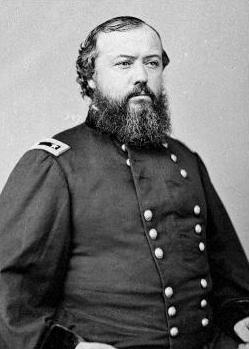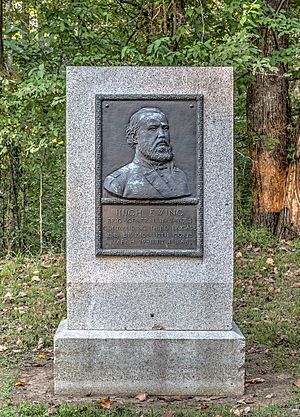Hugh Boyle Ewing facts for kids
Quick facts for kids
Hugh Boyle Ewing
|
|
|---|---|

Maj. Gen. Hugh Ewing
|
|
| Born | October 31, 1826 Lancaster, Ohio |
| Died | June 30, 1905 (aged 78) Lancaster, Ohio |
| Place of burial |
Saint Mary Cemetery, Lancaster, Ohio
|
| Allegiance | United States of America Union |
| Service/ |
United States Army Union Army |
| Years of service | 1861-1866 |
| Rank | |
| Commands held | 30th Ohio Infantry Brigade / Kanawha Division Brigade / XV Corps Division / XVI Corps 4th Division / XV Corps |
| Battles/wars | American Civil War Battle of Philippi Battle of Rich Mountain Battle of Carnifex Ferry Battle of Cheat Mountain Battle of Greenbrier River Battle of South Mountain Battle of Antietam Vicksburg Campaign Battle of Chattanooga Battle of Bentonville |
| Other work | Lawyer, U.S. Minister to Holland, Farmer, Author |
Hugh Boyle Ewing (October 31, 1826 – June 30, 1905) was an important figure in American history. He was a diplomat, a writer, a lawyer, and a general in the Union Army during the American Civil War.
Hugh Ewing came from a very well-known family. His father was Thomas Ewing, a famous politician. He was also the brother of Thomas Ewing Jr. and Charles Ewing. Interestingly, he was the foster brother and brother-in-law of William T. Sherman, who became one of the most successful Union generals. General Ewing was known for being smart, well-read, and very responsible for his soldiers.
During the Civil War, Hugh Ewing played a key role in several events. In 1861, his family's connections helped save his brother-in-law, William T. Sherman, from being removed from command. Ewing himself became one of Sherman's most trusted officers. He was at the Battle of Antietam, where his brigade helped protect the Union Army's side. He also found important letters during the Vicksburg campaign that caused trouble for a former U.S. President. After the war, Ewing served as an ambassador and became a respected author.
Early Life and Career
Hugh Ewing was born in Lancaster, Ohio. He attended the West Point military academy. However, he had to leave before graduating because he failed an engineering exam. This was a big disappointment for his family. While at West Point, he became good friends with future Union generals like John Buford Jr. and Nathaniel C. McLean.
In 1849, during the California Gold Rush, Ewing traveled to California. He joined a special trip ordered by his father, who was then the Secretary of the Interior. Their mission was to rescue immigrants stuck in the Sierra mountains due to heavy snow. He returned in 1852 with important messages for the government.
After this, he finished his law studies and started practicing law in St. Louis. From 1854 to 1856, he worked there. Then, he moved to Leavenworth, Kansas, with his younger brother, Thomas Jr., and his brothers-in-law, William T. Sherman and Hampden B. Denman. They started investing in land, roads, and government housing. They quickly built a successful law firm and a powerful land business in Leavenworth.
In 1858, Ewing married Henrietta Young. Her family was important in the history of Maryland. Soon after, he took over his father's salt production business in Ohio.
Civil War Service
In April 1861, the Governor of Ohio, William Dennison, made Ewing a brigade-inspector for Ohio volunteer soldiers. He served under generals Rosecrans and McClellan in western Virginia. In August 1861, Ewing became a colonel of the 30th Ohio Volunteer Infantry.
In November 1861, his brother-in-law, William T. Sherman, was removed from his command. Ewing helped his sister, Ellen Ewing Sherman, in Washington D.C.. They worked to deny media stories that Sherman was mentally unwell. They also personally asked President Abraham Lincoln to put Sherman back in command. Ewing and his sister argued that Sherman's requests for soldiers and supplies had been ignored. They believed the claims of insanity were part of a plan by Adjutant General Lorenzo Thomas.
Eventually, the Ewing family's political influence helped. With help from Henry Halleck, Sherman was returned to command. President Lincoln publicly praised Sherman's "talent & conduct." Later, Thomas was sent to a less important job.
Under General McClellan, Ewing first commanded a regiment and then a brigade in the Kanawha Division. This division was part of the IX Corps. In the Battle of South Mountain, he led the attack that pushed the enemy off the mountain top. Later that day, he was given command of another brigade. At the Battle of Antietam, his brigade was on the far left side of the army. According to General Ambrose Burnside, Ewing's actions "saved the left from being completely driven in."
After Antietam, Ewing took sick leave because of a long-term illness. He was promoted to Brigadier General on November 29, 1862. He then moved West and served in the Vicksburg campaign. He led attacks for General Sherman. After Vicksburg fell, he was given command of a division in the XVI Corps.
At Chattanooga, he commanded the 4th Division of the XV Corps. This division led Sherman's army and helped capture Missionary Ridge. Before the Battle of Chattanooga, Ewing's troops led a mission that destroyed a large iron works in Dade County, Georgia. This factory was being rebuilt to help the South make more weapons. Sherman thought Ewing was his most dependable division commander.
After Vicksburg, Ewing's troops damaged Confederate President Jefferson Davis's plantation. Ewing gave Davis's personal letters to his brother-in-law, Sherman. However, Ewing also sent copies of these letters to friends in Ohio. When these documents were published, they damaged the reputation of former President Franklin Pierce. The letters showed Pierce's negative views on the war and "northern abolitionism."
In October 1863, Ewing was put in charge of the Union forces in Louisville, Kentucky. He served during a difficult time when martial law was declared often. He tried to oppose harsh policies against civilians. For example, in August 1864, soldiers were ordered to execute suspected Confederate guerrillas. General Ewing believed they were innocent and asked for a pardon, but it was refused.
In his own writings, Ewing described an event in October 1862. A colonel had hit one of Ewing's soldiers with his sword. Ewing immediately confronted the colonel. He told him he would not allow such treatment of his soldiers. Ewing believed in keeping discipline by taking good care of his troops. He respected the military traditions of other units but chose a different approach for his own American soldiers. In 1865, General Ewing was sent to North Carolina. He was planning a mission up the Roanoke river when General Lee surrendered, ending the war.
In 1864, Ewing suffered from rheumatism, a painful joint condition. He received treatment many times and was often confined to his chair. He was likely very ill while commanding in Louisville. He was made a brevet major general on March 13, 1865. After leaving the Army, he continued to have painful attacks for the rest of his life.
After the War
President Andrew Johnson appointed Ewing as the U.S. Minister (like an ambassador) to Holland. He served there from 1866 to 1870. There was some discussion about replacing him, but he remained in his post. This was possibly due to the influence of his sister, whose husband, General Sherman, was a close friend of President Ulysses S. Grant.
When he returned to the United States, Ewing retired to a farm near Lancaster, Ohio. He passed away there in 1905.
Hugh Ewing was also a writer. He wrote several books, including The Black List; A Tale of Early California (1887) and A Castle in the Air (1887).


